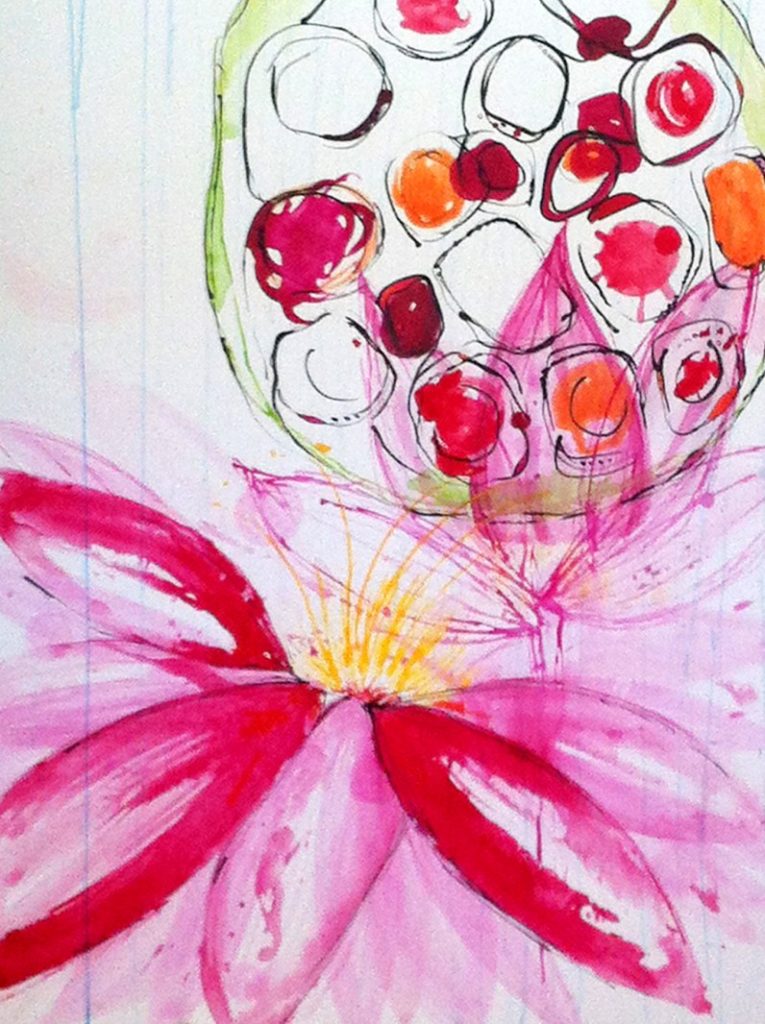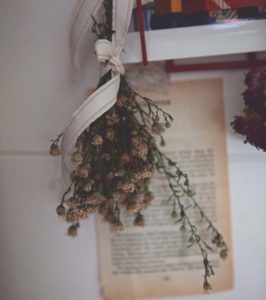True Cost/Perceived Value: Flowers & Art
Words by Fiona Chandler. Illustration by Fiona Chandler | September 29, 2014
Flowers and art sound like dream jobs. Grow some flowers, paint a picture, surround yourself with beauty. But how much is a bunch of flowers, a painting? Each of these industries is a calling. It’s a love. A love to be shared with the viewer and buyer.
With flowers the enjoyment can be fleeting. A bunch of peonies. Stunning, and lasting up to a week. Someone planted the seed. Cared for the plant. Lay awake and worried about the weather. Watered them. Woke up early in the dark to pick the best of them. Set up at the markets always taking care of the blooms. How to price these? The beauty the grower would like to share with many. Not all bunches can be $10 or even $20. They are showstoppers. People come from afar to admire and then buy a more economical bunch. Brides desire them all year round. It can be ranunculus, lilies, and crabapple blossoms. All grown, tended. A labour of love.
For a painting a subject is chosen, given or evolves. The media is governed by the immediacy of the idea. Acrylic, oil, watercolour. A feeling on paper or board. Sharing of the spirit, idea or desire. Exposed. Inspired. Work, indecision. Hours alone unseen.
With art and flowers the creator hopes to lighten the viewers heart, to open them up to ideas, a hint of a smile. Unbridled joy. Attainment. Ownership. Possession.
How to price this, then?
The ideal for my art would be to let the buyer decide. Does this attract the viewer or confuse them? Maybe a breakdown of cost like at a restaurant? Framing $200, paper $50, 20 years of experience and the buyer fills in the amount. I would like this. To discus the dollars is difficult. Most galleries and indeed artists enjoy the discourse. The ideas and reasons. Florists know more than the arranging. Ask them about the growers or the looking after of your purchase. The little bit of water needed for the hairy legs of poppies… If only more buyers of art and flowers knew. These worlds are not closed, only open to a select few. Ask a question, introduce yourself…. You will both be the richer for it.
From: https://theplanthunter.com.au/artdesign/flowers-art/
And Sometimes Like a Gleaner Thou Dost Keep
Words by Fiona Chandler | June 24, 2014
The collector brings nature into their space, unable to leave its gifts behind. These are the treasures found on a walk, which cost nothing except the time to notice and dirt on your fingers. The most beautiful often wear the tales of their life. A ragged leaf, some cobwebs, specks of dirt. Or a blossom that will never bloom after falling from the tree before its time. These collected plants, leaves sticks and pods may reside in your home for hours, days, or sometimes years. No special pot needed. A spot of glue, a piece of tape , a jar, or a nail to hang them from will do. These treasures bring pleasure, ideas and inspiration. Or of you prefer indeed they can be practical too.
This picture story by Fiona Chandler is an encouragement to stop and really see the natural world around you. There is so much beauty (and useful beauty at that!) to be found outside. Hopefully this story encourages you to rug up, put on your wellies and go exploring/collecting.
The title is an excerpt from To Autumn, by John Keats. Here is the full poem. Because it’s beautiful.
To Autumn
John Keats
1.
SEASON of mists and mellow fruitfulness,
Close bosom-friend of the maturing sun;
Conspiring with him how to load and bless
With fruit the vines that round the thatch-eves run;
To bend with apples the moss’d cottage-trees,
And fill all fruit with ripeness to the core;
To swell the gourd, and plump the hazel shells
With a sweet kernel; to set budding more,
And still more, later flowers for the bees,
Until they think warm days will never cease,
For Summer has o’er-brimm’d their clammy cells.
2.
Who hath not seen thee oft amid thy store?
Sometimes whoever seeks abroad may find
Thee sitting careless on a granary floor,
Thy hair soft-lifted by the winnowing wind;
Or on a half-reap’d furrow sound asleep,
Drows’d with the fume of poppies, while thy hook
Spares the next swath and all its twined flowers:
And sometimes like a gleaner thou dost keep
Steady thy laden head across a brook;
Or by a cyder-press, with patient look,
Thou watchest the last oozings hours by hours.
3.
Where are the songs of Spring? Ay, where are they?
Think not of them, thou hast thy music too,—
While barred clouds bloom the soft-dying day,
And touch the stubble plains with rosy hue;
Then in a wailful choir the small gnats mourn
Among the river sallows, borne aloft
Or sinking as the light wind lives or dies;
And full-grown lambs loud bleat from hilly bourn;
Hedge-crickets sing; and now with treble soft
The red-breast whistles from a garden-croft;
And gathering swallows twitter in the skies.
Photography by Leanne Ambrogio
From: https://theplanthunter.com.au/botanica/sometimes-like-gleaner-thou-dost-keep/
Fermented Memories
Words by Fiona Chandler. Illustration by Fiona Chandler | April 28, 2014
The strongest memories are usually triggered by smell, a scent that sends you back in time. But for some people who see the world as pictures rather than words, the trigger can be a shape or colour: a flash of red berries against dark green leaves. An empty milk bottle; one that actually costs money and isn’t left outside by the door where the magpies poke it, trying to eat the cream.
That was 30 years ago and all but forgotten until I spotted a cluster of red berries on a recent walk with my own children who were similarly attracted to them. As they rushed over to pick them and I called out a warning: “look, but don’t touch,” I recalled collecting bunches and bunches of them one year when I was still a child. I wanted enough to stuff an entire milk bottle. That’s a lot of berries, but I was determined to fill it to the top.
It took hours and lots of stuffing, but eventually it seemed that every crevice was full. I remember rushing back to my project after scoffing down a quick lunch to poke the last few in the top. And then, adding water.
It was to be a gift for my mum, a practical woman, not given to collecting or creating. But the treasure needed to remain hidden for another week and was constantly shuttled from one hiding place to another for fear of discovery.
The school’s Mother’s Day Stall was shunned; I had it sorted and eagerly anticipated her response to this wonderful gift.
Finally, Mother’s Day arrived. It was very early, but I couldn’t wait. I can still feel her hug, see the smile she gave me. I was happy – her response was all that I hoped it would be. My mother, on the other hand, was now the proud owner of a bottle full of fermented, poisonous Daphne berries, which had no purpose. None at all.
Sometimes the understanding of a moment comes with age and it is only now that I know who was the real recipient of a gift that day. My memory revised, I feel full of gratitude.
from: https://theplanthunter.com.au/culture/fermented-memories/
A Sunflower Shelter
Words by Fiona Chandler. Images by Fiona Chandler | January 17, 2014
From our very first cubby house under the kitchen table to a treehouse later on, the need to create a shelter is something visceral. A pull from deep within. Along with this comes the need to dig and grow. To nurture and build, no matter how haphazardly.
As soon as children are able to amble they will create homes under trees. The bush is full of natural dwellings – shelters concealed beneath bottle brush, grevillea and banksia plants. The dense growth of lantana, with its purple and yellow flowers, allows small bodies to squirm their way underneath. Children do not notice the spiders, bits of rubbish or the scratchiness. Nor do they care if it’s a weed. It is claimed as a home for the short while they are there – The length of a brothers’ football game or a quick play in the park.
Children gravitate to trees. As they grow the dwellings move from the ground to the branches. The tree dwellings begin with ancient frangipanis flowering in summer – not too far from the ground and easy to spot. From there they move on to gums with lengthy lower limbs, fig trees in the botanic gardens, camphor laurel and pine trees in back yards and lanes.
Nature and shelter are intertwined. We feel in control, creative and safe when amongst the leaves and the branches. Even now I covet a potting shed. A place that is always sunny and warm. I desire a small space of my very own, not a grown up place but a place to sit and contemplate. So, sometimes I build a sunflower shelter in my backyard. It is not a potting shed, but it’s easy to achieve and glorious in its evolution.
How To Make A Sunflower Shelter
- Find a patch of earth in the sun (or a couple of tin cans if you only have a balcony)
- Plant sunflower seeds in a in a circular shape large enough to lie inside (leave room for an entry)
- Water often
- Take a favourite towel and some cushions, lay inside and watch the sunflower heads follow the sun
- Take a book. I bet you won’t read it
- Once the flowers start to droop snip their heads off
- Put them on a windowsill and let them dry in the sun
- Pick the seeds out and packet them for next year
Wouldn’t it be lovely if all shelters were this simple…
The collage is a collection of homegrown seeding herbs…plus bits too interesting to ignore. I usually paint and illustrate but am finding so many treasures that my nature table is overflowing and I need to incorporate them in my work. The collages only last the length of time it takes to shoot them and then they head of to the compost or are blown into the garden. I love the transience of each piece.
From: https://theplanthunter.com.au/howto/sunflower-shelter/













